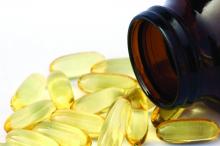A daily dose of 2,000 IU of vitamin D had no impact on reducing wintertime upper respiratory tract infections in young children, compared with a 400 IU dose, based on a study of 703 children aged 1-5 years. The report was published July 18 in JAMA.
“Vitamin D increases the synthesis of the antimicrobial peptide cathelicidin in respiratory epithelium, which has been shown to reduce disease severity and replication of the influenza virus in vitro,” but studies on the effect of vitamin D on upper respiratory infections have been limited, wrote Mary Aglipay of St. Michael’s Hospital, Toronto, and her colleagues.
To assess the impact of vitamin D on upper respiratory infections, the researchers randomized healthy children (average age 2.7 years) to 2,000 IU or 400 IU of vitamin D daily for at least 4 months between September and May each year between 2011 and 2015 (JAMA. 2017;318:245-54).The average number of laboratory-confirmed cases of upper respiratory tract infections per child was not significantly different between the high-dose and low-dose groups (1.05 vs. 1.03).
The median time to the first laboratory-confirmed infection was similar between the groups: 3.95 months in the high-dose group and 3.29 months in the low-dose group. In addition, the number of parent-reported upper respiratory tract infections was similar between the high-dose and low-dose groups (625 vs. 600).
Serum 25-hydroxyvitamin D levels also remained comparable between the high-dose and low-dose groups at the study’s end (48.7 ng/mL vs. 36.8 ng/mL).
The results were limited by several factors, including the lack of a placebo group and the high baseline vitamin D levels in the children at the end of the summer, the researchers noted.
However, “these findings do not support the routine use of high-dose vitamin D supplementation in children for the prevention of viral upper respiratory tract infection,” they said.
The study was supported by the Canadian Institutes of Health Research, Institute of Human Development, Child and Youth Health, and Institute of Nutrition, Metabolism and Diabetes, and the Thrasher Research Fund. The vitamin D formulations were donated by Ddrops. Ms. Aglipay had no financial conflicts to disclose. One coauthor, Muhammad Mamdani, MPH, had ties to a number of pharmaceutical companies.


